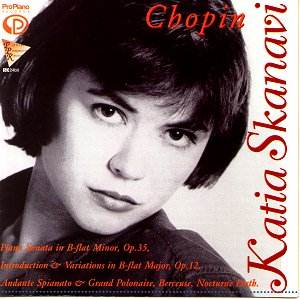GUEST REVIEW
FROM INTERNATIONAL RECORD
REVIEW
CHOPIN Introduction and Variations in B flat
on 'Je vends des scapulaires' from Hérold's Ludovic, Op. 12. Andante
spianato and Grand polonaise in E flat, Op. 22. Berceuse in D flat, Op. 57.
Nocturne in C sharp minor, Op. Posth. Piano Sonata No. 2 in B flat minor,
Op. 35.
 Katia Skanavi (piano).
Katia Skanavi (piano).
 ProPiano Records
PPR224522 (full price, 55 minutes).
ProPiano Records
PPR224522 (full price, 55 minutes).
Producers Chitose Okashiro, Ricard de La Rosa.
Engineer Carl Talbot. Date June 3rd-4th, 1998. Purchase from
Crotchet
£12.95
Comparison:
Sonata No. 2:
Horowitz (RCA) (1950) GD60376

Katia Skanavi offers a Chopin recital of searing temperament and rich sonority,
recorded on a finely prepared Hamburg Steinway and in startlingly lifelike
sound by ProPiano. Now 29, Skanavi has suffered a number of near misses at
competitions - most recently the Tenth Van Cliburn in Fort Worth,
where the jury plumped for the safer playing of Jon Nakamatsu, much to the
consternation of many audience members - but has nevertheless built
up an impressive concert career.
The rarely-heard Variations on 'Je vends des scapulaires' from Hérold's
Ludovic (once a favourite of Cziffra's) sparkle with a coquettish wit; Skanavi
gives the impression that the music could dart fancifully in any direction
at any moment, yet the control remains resolute. The Andante spianato is
hushed and highly concentrated - the unusual degree of rubato Skanavi
allows the right hand's flourishes brings variety without breaking the undulating
flow - before the Grande polonaise takes off exuberantly at a
commanding clip, the operatic high jinks projected with flair and a strutting
confidence. The Berceuse, by contrast, occupies an ethereal inner
world - in Skanavi's hands it is a lullaby that somehow mixes naivety
with a bewitching sophistication. In spite of a few mis-weightings (a similar
story in the central section of the Funeral March movement of the Sonata),
the control of pianissimo tone is often mesmerizing - Skanavi can
shade down phrases so that she seems to be evoking no more than shadows of
notes. The C sharp minor Nocturne is almost too still for its own good, but
then the Second Sonata takes off, after the ominous opening declamation,
with huge propulsive energy, catapulting the listener into the first subject
and beyond with dynamic and rhythmic abandon. Although climaxes sometimes
fail to register their full impact (so much pulsating excitement having already
been created along the way), there is no doubt that playing of such
sweep - with perceptive voicing, colouring and pedalling to
match - injects this much-heard work with a daring, sometimes
transforming shot of adrenaline. For Skanavi, the movements are clearly not
'four of Chopin's most unruly children under one roof' (in Schumann's words),
but unified via a shared inspiration in the dark textures, harmonies and
anguish of the Marche funèbre. The demonica at times recalls the gothic
swagger and malevolence of Horowitz's first account on RCA, if not its desperate
ferocity. Periodically it becomes evident, however, that Skanavi's responses
where poetry and meditation are called for are not quite as exceptional or
as individual as those born of her tactile engagement with rampant octaves,
double notes and leaps, and the middle sections of the second and third movements
ring hollow amid the powerful (at times theatrical) drama that surrounds
them. The finale flickers menacingly before a sudden infernal gust leads
to the appearance of the closing B flat minor chord.
Some listeners will doubtless find Skanavi's approach as wilful and slick
as others will find it involving and tempestuous, but playing of such
accomplishment and vivid character demands to be heard.
Reviewer
Michael Glover
This review will appear in the June issue of
INTERNATIONAL RECORD
REVIEW
